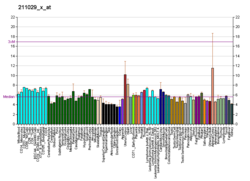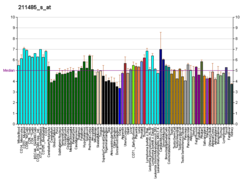FGF18
FGF18(fibroblast growth factor 18)は、ヒトではFGF18遺伝子にコードされるタンパク質である[5][6][7]。1998年に、マウスでFgf8と密接に関連している遺伝子としてFgf17とともに発見され、記載された[8]。
FGF18タンパク質はFGFファミリーに属する。FGFファミリーのメンバーは幅広い分裂促進活性や細胞生存活性を有し、胚発生、細胞成長、形態形成、組織修復などさまざまな生物学的過程に関与している。中でもFGF8、FGF17、FGF18の3つのタンパク質はまとめてFGF8サブファミリーへと分類される[9]。FGF18は軟骨形成の促進[10]や関節の硝子軟骨の形成[11]における役割が特定されており、またin vitroではPC12細胞の神経突起の成長を誘導することが示されている[12]。
機能
[編集]FGF18は線維芽細胞増殖因子受容体(FGFR)ファミリー、特にFGFR3c(続いて、4Δ、2c、1c、最後に3b)に選択的に結合し[13]、FGFR3を介したシグナル伝達によって軟骨の形成を促進する[14]。変形性関節症のラットモデルにおいて、FGF18は軟骨の厚みの増加を引き起こすことが示されており[15]、組換え型FGF18(スプリフェルミン)は変形性関節症治療薬としての臨床試験が行われている[16]。近年のプラセボ対照盲検化臨床試験では、FGF18が人工関節手術を要するまでの進行速度を遅らせ[17]、変形性関節症と関連した痛みの進行(WOMACスコアによる)を遅らせる可能性が示されている[18]。
マウスやニワトリのホモログの研究からは、FGF18がいくつかの組織で増殖を刺激する多面的な成長因子であることが示唆されており、特にこの作用は肝臓と小腸で顕著である。マウスのFgf18遺伝子のノックアウト研究では、このタンパク質が小脳の正中部構造の増殖と分化を調節している可能性が示唆されている[7]。
また心臓では、FGF18はストレスによって誘発される病理的な心肥大を緩和することがマウスで示されている[19]。同様に、肝臓におけるFGF18の過剰発現は化学物質によって誘発された肝損傷後の線維化を緩和することが確認されている[20]。
がんとの関係においては、FGF18はいくつかの種類やステージにおいて増加[21]と減少[22]の双方が示されている。しかしながら、FGF18はがんの原因や予後に影響を与える因子ではないようであり[22]、FGF18アナログであるスプリフェルミンを用いた長期の臨床研究では、発がん作用を持たない優れた安全性プロファイルが実証されている[23]。
出典
[編集]- ^ a b c GRCh38: Ensembl release 89: ENSG00000156427 - Ensembl, May 2017
- ^ a b c GRCm38: Ensembl release 89: ENSMUSG00000057967 - Ensembl, May 2017
- ^ Human PubMed Reference:
- ^ Mouse PubMed Reference:
- ^ “Structure and expression of the mRNA encoding a novel fibroblast growth factor, FGF-18”. J Biol Chem 273 (29): 18161–4. (Aug 1998). doi:10.1074/jbc.273.29.18161. PMID 9660775.
- ^ “FGF-18, a Novel Member of the Fibroblast Growth Factor Family, Stimulates Hepatic and Intestinal Proliferation”. Mol Cell Biol 18 (10): 6063–74. (Nov 1998). doi:10.1128/MCB.18.10.6063. PMC 109192. PMID 9742123.
- ^ a b “Entrez Gene: FGF18 fibroblast growth factor 18”. 2024年9月15日閲覧。
- ^ Maruoka, Y.; Ohbayashi, N.; Hoshikawa, M.; Itoh, N.; Hogan, B. L.; Furuta, Y. (June 1998). “Comparison of the expression of three highly related genes, Fgf8, Fgf17 and Fgf18, in the mouse embryo”. Mechanisms of Development 74 (1–2): 175–177. doi:10.1016/s0925-4773(98)00061-6. ISSN 0925-4773. PMID 9651520.
- ^ Itoh, Nobuyuki; Ornitz, David M. (November 2004). “Evolution of the Fgf and Fgfr gene families”. Trends in Genetics 20 (11): 563–569. doi:10.1016/j.tig.2004.08.007. ISSN 0168-9525. PMID 15475116.
- ^ Moore, E. E.; Bendele, A. M.; Thompson, D. L.; Littau, A.; Waggie, K. S.; Reardon, B.; Ellsworth, J. L. (July 2005). “Fibroblast growth factor-18 stimulates chondrogenesis and cartilage repair in a rat model of injury-induced osteoarthritis”. Osteoarthritis and Cartilage 13 (7): 623–631. doi:10.1016/j.joca.2005.03.003. ISSN 1063-4584. PMID 15896984.
- ^ Hollander, Judith M.; Goraltchouk, Alex; Rawal, Miraj; Liu, Jingshu; Luppino, Francesco; Zeng, Li; Seregin, Alexey (2023-03-06). “Adeno-Associated Virus-Delivered Fibroblast Growth Factor 18 Gene Therapy Promotes Cartilage Anabolism”. Cartilage 14 (4): 492–505. doi:10.1177/19476035231158774. ISSN 1947-6043. PMC 10807742. PMID 36879540.
- ^ Ohbayashi, N.; Hoshikawa, M.; Kimura, S.; Yamasaki, M.; Fukui, S.; Itoh, N. (1998-07-17). “Structure and expression of the mRNA encoding a novel fibroblast growth factor, FGF-18”. The Journal of Biological Chemistry 273 (29): 18161–18164. doi:10.1074/jbc.273.29.18161. ISSN 0021-9258. PMID 9660775.
- ^ Ornitz, David M.; Itoh, Nobuyuki (2015). “The Fibroblast Growth Factor signaling pathway”. Wiley Interdisciplinary Reviews. Developmental Biology 4 (3): 215–266. doi:10.1002/wdev.176. ISSN 1759-7692. PMC 4393358. PMID 25772309.
- ^ Davidson, D.; Blanc, A.; Filion, D.; Wang, H.; Plut, P.; Pfeffer, G.; Buschmann, M. D.; Henderson, J. E. (2005). “Fibroblast Growth Factor (FGF) 18 Signals through FGF Receptor 3 to Promote Chondrogenesis”. Journal of Biological Chemistry 280 (21): 20509–20515. doi:10.1074/jbc.M410148200. PMID 15781473.
- ^ Moore, E.; Bendele, A.; Thompson, D.; Littau, A.; Waggie, K.; Reardon, B.; Ellsworth, J. (2005). “Fibroblast growth factor-18 stimulates chondrogenesis and cartilage repair in a rat model of injury-induced osteoarthritis”. Osteoarthritis and Cartilage 13 (7): 623–631. doi:10.1016/j.joca.2005.03.003. PMID 15896984.
- ^ Merck Announces Collaboration With Nordic Bioscience for Sprifermin in Osteoarthritis of the Knee 2013年4月2日閲覧。
- ^ Eckstein, Felix; Hochberg, Marc C.; Guehring, Hans; Moreau, Flavie; Ona, Victor; Bihlet, Asger Reinstrup; Byrjalsen, Inger; Andersen, Jeppe Ragnar et al. (August 2021). “Long-term structural and symptomatic effects of intra-articular sprifermin in patients with knee osteoarthritis: 5-year results from the FORWARD study”. Annals of the Rheumatic Diseases 80 (8): 1062–1069. doi:10.1136/annrheumdis-2020-219181. ISSN 1468-2060. PMC 8292562. PMID 33962962.
- ^ Conaghan, P. G.; Katz, N.; Hunter, D.; Guermazi, A.; Hochberg, M.; Somberg, K.; Clive, J.; Johnson, M. et al. (2023-06-01). “Pos1348 Effects of Sprifermin on a Novel Outcome of Osteoarthritis Symptom Progression: Post-Hoc Analysis of the Forward Randomized Trial” (英語). Annals of the Rheumatic Diseases 82 (Suppl 1): 1025–1026. doi:10.1136/annrheumdis-2023-eular.2454. ISSN 0003-4967.
- ^ Chen, Gen; An, Ning; Shen, Jingling; Chen, Huinan; Chen, Yunjie; Sun, Jia; Hu, Zhicheng; Qiu, Junhui et al. (2023-03-04). “Fibroblast growth factor 18 alleviates stress-induced pathological cardiac hypertrophy in male mice”. Nature Communications 14 (1): 1235. doi:10.1038/s41467-023-36895-1. ISSN 2041-1723. PMC 9985628. PMID 36871047.
- ^ Tong, Gaozan; Chen, Xixi; Lee, Jongsuk; Fan, Junfu; Li, Santie; Zhu, Kunxuan; Hu, Zijing; Mei, Lin et al. (April 2022). “Fibroblast growth factor 18 attenuates liver fibrosis and HSCs activation via the SMO-LATS1-YAP pathway”. Pharmacological Research 178: 106139. doi:10.1016/j.phrs.2022.106139. ISSN 1096-1186. PMID 35202822.
- ^ Flannery, Clare A.; Fleming, Andrew G.; Choe, Gina H.; Naqvi, Hanyia; Zhang, Margaret; Sharma, Anu; Taylor, Hugh S. (October 2016). “Endometrial Cancer-Associated FGF18 Expression Is Reduced by Bazedoxifene in Human Endometrial Stromal Cells In Vitro and in Murine Endometrium”. Endocrinology 157 (10): 3699–3708. doi:10.1210/en.2016-1233. ISSN 1945-7170. PMC 5045514. PMID 27267714.
- ^ a b Mosleh, Berta; Schelch, Karin; Mohr, Thomas; Klikovits, Thomas; Wagner, Christina; Ratzinger, Lukas; Dong, Yawen; Sinn, Katharina et al. (2023-06-21). “Circulating FGF18 is decreased in pleural mesothelioma but not correlated with disease prognosis”. Thoracic Cancer 14 (22): 2177–2186. doi:10.1111/1759-7714.15004. ISSN 1759-7714. PMC 10396789. PMID 37340889.
- ^ Eckstein, Felix; Hochberg, Marc C.; Guehring, Hans; Moreau, Flavie; Ona, Victor; Bihlet, Asger Reinstrup; Byrjalsen, Inger; Andersen, Jeppe Ragnar et al. (August 2021). “Long-term structural and symptomatic effects of intra-articular sprifermin in patients with knee osteoarthritis: 5-year results from the FORWARD study”. Annals of the Rheumatic Diseases 80 (8): 1062–1069. doi:10.1136/annrheumdis-2020-219181. ISSN 1468-2060. PMC 8292562. PMID 33962962.
関連文献
[編集]- “A review of FGF18: Its expression, signaling pathways and possible functions during embryogenesis and post-natal development”. Histol. Histopathol. 22 (1): 97–105. (2007). PMID 17128416.
- “Human fibroblast growth factor-18 stimulates fibroblast cell proliferation and is mapped to chromosome 14p11”. Oncogene 18 (16): 2635–42. (1999). doi:10.1038/sj.onc.1202616. PMID 10353607.
- “Temporal and spatial gradients of Fgf8 and Fgf17 regulate proliferation and differentiation of midline cerebellar structures”. Development 127 (9): 1833–43. (2000). doi:10.1242/dev.127.9.1833. PMID 10751172.
- “DNA Cloning Using In Vitro Site-Specific Recombination”. Genome Res. 10 (11): 1788–95. (2001). doi:10.1101/gr.143000. PMC 310948. PMID 11076863.
- Whitmore TE; Maurer MF; Sexson S; Raymond, F.; Conklin, D.; Deisher, T.A. (2001). “Assignment of fibroblast growth factor 18 (FGF18) to human chromosome 5q34 by use of radiation hybrid mapping and fluorescence in situ hybridization”. Cytogenet. Cell Genet. 90 (3–4): 231–3. doi:10.1159/000056775. PMID 11124520.
- Simpson JC; Wellenreuther R; Poustka A; Pepperkok, R; Wiemann, S (2001). “Systematic subcellular localization of novel proteins identified by large-scale cDNA sequencing”. EMBO Rep. 1 (3): 287–92. doi:10.1093/embo-reports/kvd058. PMC 1083732. PMID 11256614.
- Strausberg RL; Feingold EA; Grouse LH; Derge, JG; Klausner, RD; Collins, FS; Wagner, L; Shenmen, CM et al. (2003). “Generation and initial analysis of more than 15,000 full-length human and mouse cDNA sequences”. Proc. Natl. Acad. Sci. U.S.A. 99 (26): 16899–903. Bibcode: 2002PNAS...9916899M. doi:10.1073/pnas.242603899. PMC 139241. PMID 12477932.
- Clark HF; Gurney AL; Abaya E; Baker, K; Baldwin, D; Brush, J; Chen, J; Chow, B et al. (2003). “The Secreted Protein Discovery Initiative (SPDI), a Large-Scale Effort to Identify Novel Human Secreted and Transmembrane Proteins: A Bioinformatics Assessment”. Genome Res. 13 (10): 2265–70. doi:10.1101/gr.1293003. PMC 403697. PMID 12975309.
- “Functional phylogeny relates LET-756 to fibroblast growth factor 9”. J. Biol. Chem. 279 (38): 40146–52. (2004). doi:10.1074/jbc.M405795200. PMID 15199049.
- Gerhard DS; Wagner L; Feingold EA; Shenmen, CM; Grouse, LH; Schuler, G; Klein, SL; Old, S et al. (2004). “The Status, Quality, and Expansion of the NIH Full-Length cDNA Project: The Mammalian Gene Collection (MGC)”. Genome Res. 14 (10B): 2121–7. doi:10.1101/gr.2596504. PMC 528928. PMID 15489334.
- Wiemann S; Arlt D; Huber W; Wellenreuther, R; Schleeger, S; Mehrle, A; Bechtel, S; Sauermann, M et al. (2004). “From ORFeome to Biology: A Functional Genomics Pipeline”. Genome Res. 14 (10B): 2136–44. doi:10.1101/gr.2576704. PMC 528930. PMID 15489336.
- “Expression of fibroblast growth factors 18 and 23 during human embryonic and fetal development”. Gene Expr. Patterns 5 (4): 569–73. (2005). doi:10.1016/j.modgep.2004.10.008. PMID 15749088.
- Antoine M; Wirz W; Tag CG; Mavituna, M.; Emans, N.; Korff, T.; Stoldt, V.; Gressner, A. M. et al. (2005). “Expression pattern of fibroblast growth factors (FGFs), their receptors and antagonists in primary endothelial cells and vascular smooth muscle cells”. Growth Factors 23 (2): 87–95. doi:10.1080/08977190500096004. PMID 16019430.
- Mehrle A; Rosenfelder H; Schupp I; Del Val, C; Arlt, D; Hahne, F; Bechtel, S; Simpson, J et al. (2006). “The LIFEdb database in 2006”. Nucleic Acids Res. 34 (Database issue): D415–8. doi:10.1093/nar/gkj139. PMC 1347501. PMID 16381901.
- Antoine M; Wirz W; Tag CG; Gressner, A.M.; Wycislo, M.; Müller, R.; Kiefer, P. (2006). “Fibroblast growth factor 16 and 18 are expressed in human cardiovascular tissues and induce on endothelial cells migration but not proliferation”. Biochem. Biophys. Res. Commun. 346 (1): 224–33. doi:10.1016/j.bbrc.2006.05.105. PMID 16756958.
- Riley BM; Mansilla MA; Ma J; Daack-Hirsch, S.; Maher, B. S.; Raffensperger, L. M.; Russo, E. T.; Vieira, A. R. et al. (2007). “Impaired FGF signaling contributes to cleft lip and palate”. Proc. Natl. Acad. Sci. U.S.A. 104 (11): 4512–7. Bibcode: 2007PNAS..104.4512R. doi:10.1073/pnas.0607956104. PMC 1810508. PMID 17360555.







